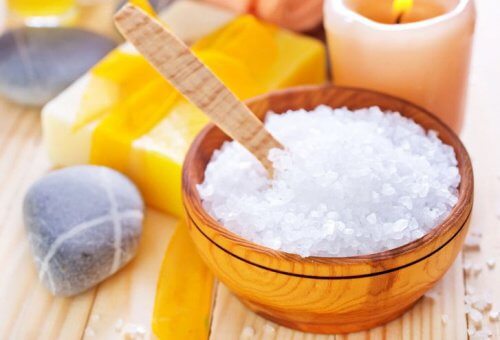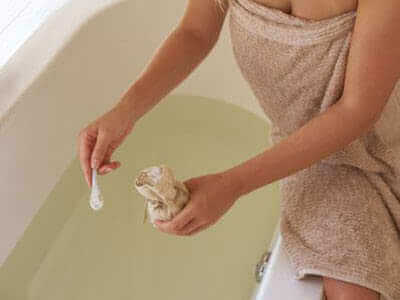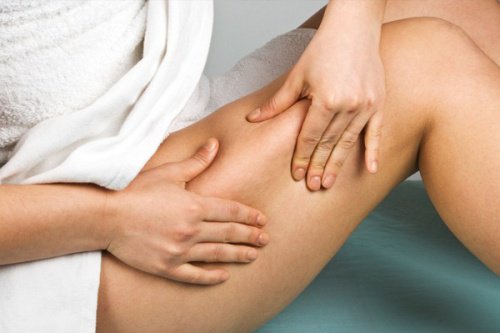The Benefits of Sea Salt for Cellulite


Written and verified by psychologist Valeria Sabater
Cellulite. How could you ever get used to living with it? Almost 80% of women suffer from cellulite. While it has a clear hereditary component, don’t forget that a poor diet and leading a sedentary lifestyle will do nothing but make that dimpled skin even more visible. Can it be true that there are some benefits of sea salt for cellulite?
Of course, you can’t get rid of cellulite completely, but you can reduce its visibility. Not only that, but trimming your figure will make it much less noticeable when you get back into your bikini for the summer.
Fighting cellulite requires daily effort. You have to maintain a proper diet and exercise regularly to help you burn stored fat. But there are also some excellent treatments that you can use every week to improve its appearance. One of these treatments harnesses the benefits of sea salt for cellulite.
In today’s article we want to show you how one of the benefits of sea salt for cellulite may be to reduce the appearance of this condition. Are you ready to learn how?
Benefits of sea salt for cellulite

Not too long ago, we said that, aside from the benefits of sea salt for cellulite, it can be beneficial when it comes to treating acne. This natural product is available in nearly all grocery stores and natural food stores. Many people don’t know that it’s a great way to decongest the tissue underneath the skin.
If you turn this sea salt treatment into more than just a part of your daily beauty routine, you’ll be starting the work of eliminating some harmful toxins from your skin.
Sea salt treatment for fighting cellulite

Ingredients
- 1 cup of sea salt (250 g)
- 1/2 cup of baking soda (125 g)
- 1 cup of magnesium sulfate salts (250 g)
- 20 drops of essential oil of cypress or grapefruit
- 20 drops of pine essential oil
- 15 drops of tangerine essential oil
See Also: 6 Weird Uses for Baking Soda
Preparation
- You should try to prepare this bath at least once or twice a week. You’ll need to set aside between 35 and 40 minutes to soak and take advantage of the natural elements you use. We should also point out that you can use any essential oils you’d like for this recipe, but cypress essential oil is especially good. Why? Some say that it’s very effective agent against inflammation, helping to reduce the nodules of fat of your skin. Cypress essential oil can be found in both specialty natural stores as well as perfumeries, and is also useful for treating acne or other types of skin inflammation.
- The first thing you need to do is to mix all ingredients together in a bowl: the sea salt, baking soda, magnesium sulfate, and essential oils. Stir them thoroughly using a wooden spoon. Don’t add any water just yet.
- The second step is simple: pour half of this mixture into the hot bath water you prepared previously.
- Now, using an exfoliating sponge, you can use the other half of the sea salt mixture to massage your thighs or any other area where you have cellulite. Your massage should be energetic and circular to activate the blood flow and ensure that all the ingredients come into contact with your skin.
- After you’ve finished with the massage, stay in the bathtub and soak for another 35 to 40 minutes. Then you can rinse and dry off normally. Remember that for maximum effectiveness on the appearance of cellulite, you need more than just such treatments. It’s important to combine them with the other tips we mentioned in the beginning.
Additional tips to complement your sea salt treatment for cellulite

- Completely eliminate salt, sugar, and soft drinks from your diet. These only cause more inflammation and fluid retention, leading to the toxin buildup!
- Increase the amount of water your consume. It’s best to always start out your day with a glass of warm water and lemon juice.
- Walk every day for half an hour and do some specific exercises that are targeted to increase the strength and endurance of your legs. Swimming, for example, is an ideal activity that covers both of these needs.
Also Read: Delicious Broccoli Recipes
- Add the following foods to your diet:
- Broccoli
- Beets
- Bell peppers
- Onion
- Kale
- Carrots
- Spinach
- Cranberries
- Pineapple
- Cantaloupe
- Celery
- Cucumber
- Pumpkin seeds
- Flaxseed
- Chia seeds
- Papaya
- Blueberries
- Cherries
- Green tea
- Sage tea
- Oats
All cited sources were thoroughly reviewed by our team to ensure their quality, reliability, currency, and validity. The bibliography of this article was considered reliable and of academic or scientific accuracy.
- Gunderson, C. (2012). Celulitis: definición, etiología y manifestaciones clínicas. Revista de Enfermedades Infecciosas En Pediatría.
- Mateos, A. J. M., & Morales, M. D. M. (2007). Celulitis periorbitaria y celulitis orbitaria. FMC Formacion Medica Continuada En Atencion Primaria. https://doi.org/10.1016/S1134-2072(07)71894-7
- Maestro Durán, R., & Borja Padilla, R. (1993). Actividad antioxidante de los compuestos fenólicos. Grasas y Aceites. https://doi.org/10.3989/gya.1993.v44.i2.1105
- FICA, A. (2003). Celulitis y erisipela: Manejo en atención primaria. Revista chilena de infectología, 20(2), 104-110. https://scielo.conicyt.cl/scielo.php?pid=S0716-10182003000200004&script=sci_arttext
- Koutkia P, Mylonakis E, Boyce J. (1999). Cellulitis: evaluation of possible predisposing factors in hospitalized patients. Diagn Microbiol Infect Dis 1999; 34: 325-7.
- Roe, E., Serra, E., Guzman, G., & Sajoux, I. (2018). Structural changes of subcutaneous tissue valued by ultrasonography in patients with cellulitis following treatment with the PnKCelulitis® program. Journal of Clinical and Aesthetic Dermatology.
- Josefina de Peña, M. H.-P. (2005). Lipodistrofia ginecoide (celulitis). Rev Cent Dermatol Pascua.
- ANDINA, S. (n.d.). La sal que cura. https://prama.com.ar/wp-content/uploads/sal_andina.pdf
This text is provided for informational purposes only and does not replace consultation with a professional. If in doubt, consult your specialist.








